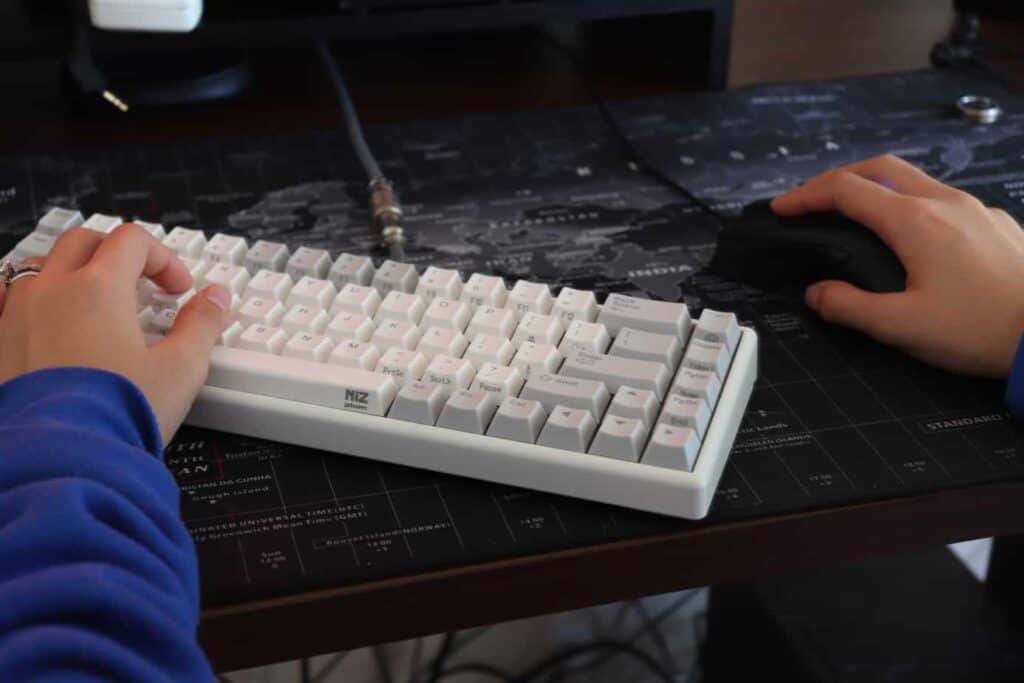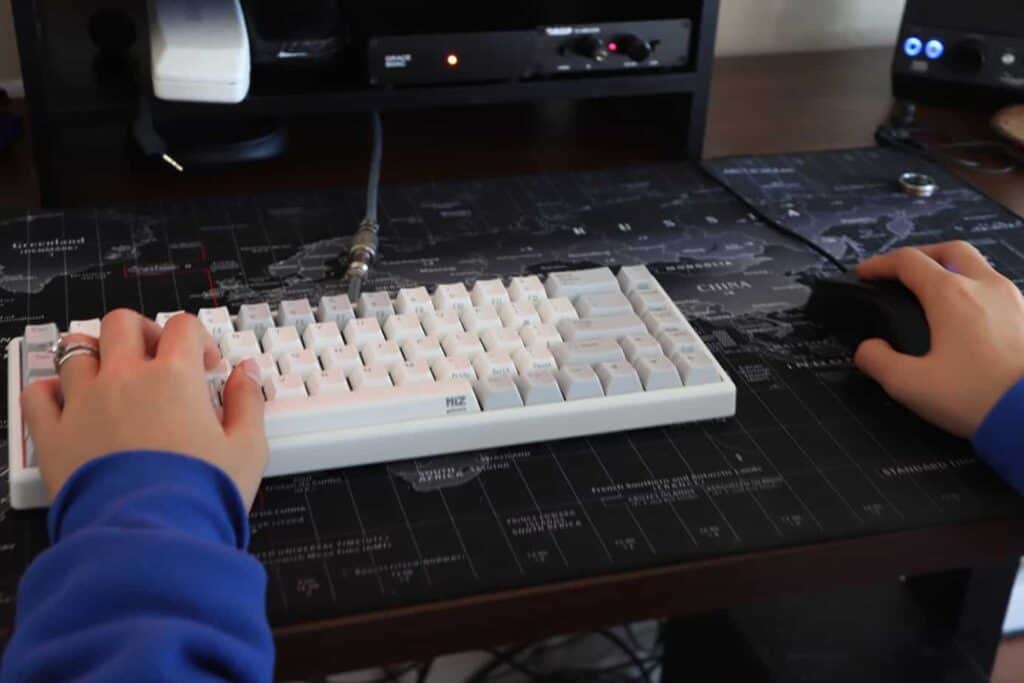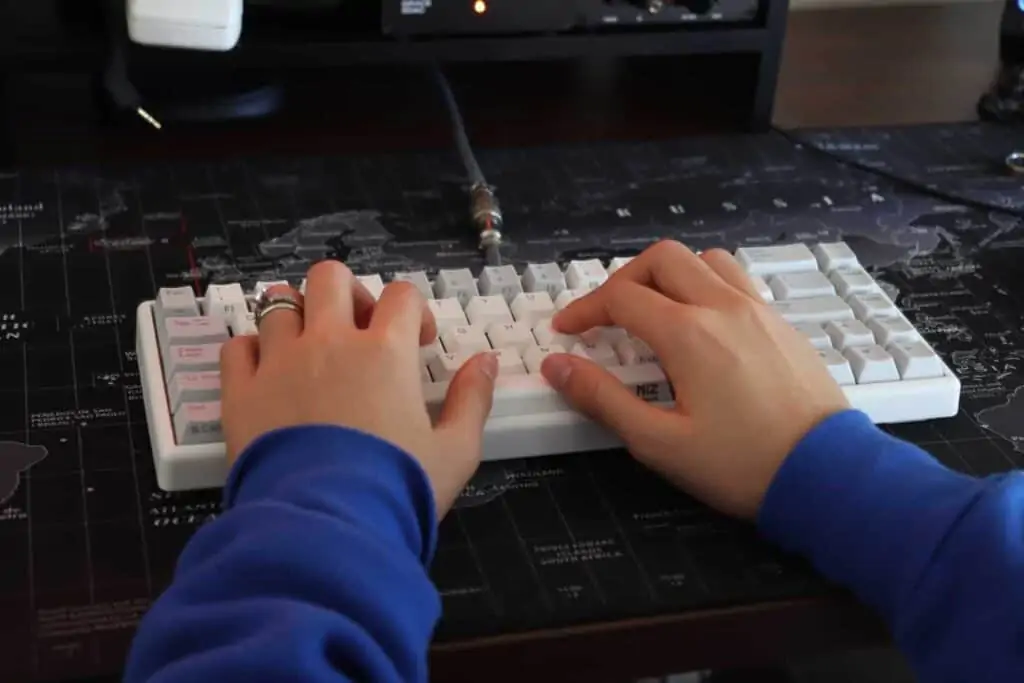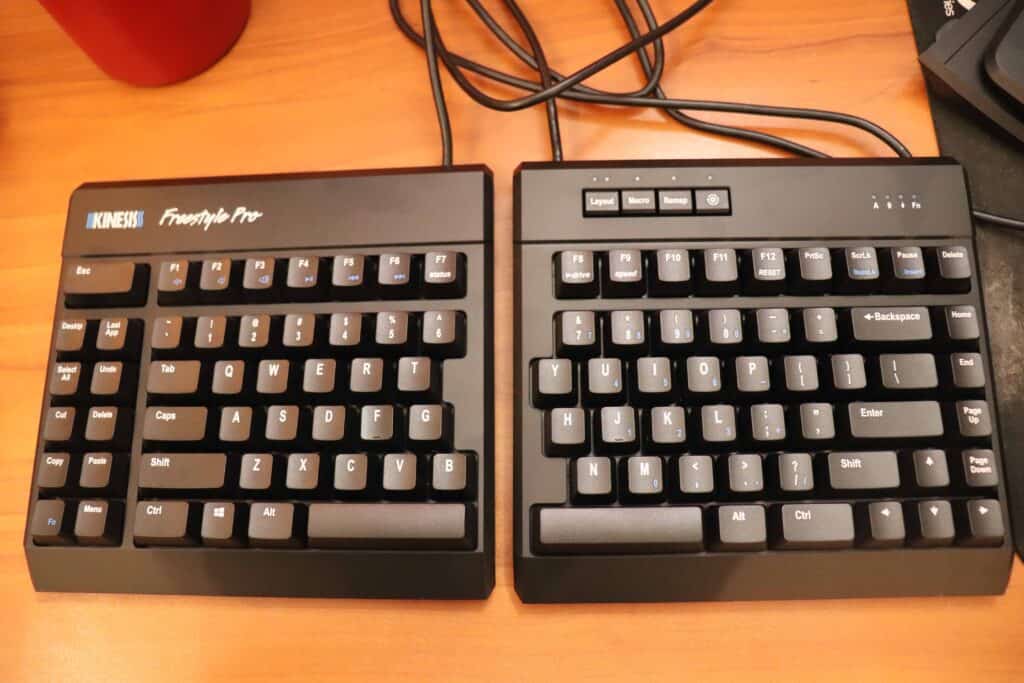If your relationship with your computer is causing a pain in your back-side, you can help ensure a happy ending by making some simple adjustments to your keyboard and mouse position.
The last thing you need are aches and pains keeping you from what you love.
Let’s see what the best keyboard and mouse position is for you, in any given situation.
Best Keyboard and Mouse Positions
The best keyboard and mouse position will depend entirely on the situation and intended usage, but for most people can be separated in to three groups: Intense Gaming, Casual Gaming, and Typing/General Use.
Best For Intense Gaming: Angled Keyboard and Mouse

Keyboard Position
For intensive gaming, many gamers choose to tilt their keyboard and mouse, often at a 30 to 45 degree angle.
Mouse Position
With a tilted keyboard, your mouse will likely also be pivoted to match the angle of your right hand and forearm.
It will give you a range of motion from the top of the keyboard to the edge of your desk.
Why Do Gamers Tilt Their Keyboard And Mouse?
Rotating your keyboard and mouse may seem like a strange choice at first, but it is a result of the posture gamers commonly take while playing an intense game.
As the gamer leans into the screen, elbows flare out and are placed on the desk or edge for support and as a pivot, and typically cause the forearms to rest at an angle on the desk.
Rather than leaving the keyboard and mouse straight and resorting to extremely bent wrists, they are placed at a comfortable angle, allowing for straight wrists and easy access.
It might look weird at first, but it is a more ergonomic layout that allows gamers to use their keyboards easily and comfortably even in the most intense situations.
It obviously is not the best posture or position to keep for long-term use, but it makes the best out of what is sometimes a necessary evil.
Best for Casual Gaming: One For Each Hand

Keyboard Position
If you are gaming more casually and only require one hand on the keyboard, then it would be in your best interest to move your keyboard more to the left (or right) of your workspace with whichever hand you use.
This helps with posture and prevents internal rotation of the shoulders by allowing both elbows and wrists to be shoulder-width apart, or whatever feels best for you.
If you are only going to be using one hand on a portion of the keyboard, and not typing, then there is no need to keep the keyboard in any particular position, other than what feels best for you.
Mouse Position
With your keyboard aligned with your primary hand, you have effectively increased real-estate for your mouse.
With several more inches of space and a shorter distance to center, you have a much more natural, wider range of motion that won’t strain your shoulder or arm.
As long as your mouse position feels natural, it will be better for your comfort.
This is a more ideal position for your posture and health while gaming.
Best for Typing and General Use: Centered Keyboard or Stacked Layout

Keyboard Position
If both hands need to be on the keyboard, the most ideal keyboard position for comfort is so that the alphas are centered along your body’s center line.
You want your arms to be the same distance from center for maximum comfort and to reduce strain and internal rotation.
Mouse Position
The downside to central placement is that anything wider than a 60% or 65% keyboard will affect your mouse position.
The more columns that are added to the right side of the alphas, the further away your mouse will be.
In the case of a full-sized keyboard with numpad, could mean at least 6-inches further from center than a compact 60% keyboard.
If you have a wired mouse or like the more traditional horizontal layout, just make sure your mouse position is comfortable.
If you have a wireless mouse, and have a little desk space between your arms while typing, you can consider the stacked layout.
Instead of tilted or side-by-side in a horizontal layout, your keyboard and mouse are stacked in a vertical arrangement.
When typing, it is just as ideal to just keep your mouse as close to center as possible to minimize stretching and strain.
A stacked layout allows you to move your hand down rather than to the right for an ergonomic arrangement that could work well for you.
Solutions for Ergonomics and Productivity
Trackpoint/Integrated Mouse keyboards
Prebuilt trackpoint keyboards like the Tex Yoda/Shinobi and the Lenovo Keyboards make use of Lenovo trackpoint, a nub-like pointing device familiar to anyone who has ever used a Thinkpad computer.
Having a mouse option in the center of the keyboard is an invaluable comfort, convenience, and productivity hack. Not recommended for games.
Split Keyboards
Split keyboards are great for people who can touch-type, because they essentially cut the keyboard in two pieces.
By extending the distance between the two halves, you can have your elbows and wrists further apart, for a more natural and comfortable typing experience.
You also get the extra desk-space between the halves for devices and peripherals.
Some Split keyboards like the Ultimate Hacking Keyboard in fact make use of your thumbs by including trackball and trackpoint modules and housings.
More extreme varieties like the Keymouse make the entire keyboard into a mouse itself.
An alternative to a Split keyboard is to use two keyboards, but that is not the most practical solution.
Wireless Mouse/Trackpad/Trackball
With a wireless mouse, trackpad, or trackball, productivity and convenience can be improved by positioning your keyboard and mouse in the stacked arrangement mentioned above.
In this way, your hand only has to move down instead of further to the right.
This will require more desk space beneath your keyboard for mouse movement, so make sure you can accommodate it.
Though a trackball or trackpad might be more ideal for this, a mouse with high DPI settings could accommodate for the limited area.
Integrating these input solutions is meant to not only increase productivity, but comfort and ergonomics as well, by eliminating the need to reach for a mouse further away from center.
After a certain point there may be diminishing returns on productivity and efficiency, but that is up to you to decide.
Positioning of Everything Else Matters Too
Of course, you can’t just rely on changing the position of your peripherals to solve all of your problems. You have to address how everything contributes to the bigger picture.
Not only does your own posture matter, but also the height of your desk, your chair, and whether you are standing or sitting.
Posture
Make sure you are sitting up straight with your shoulders aligned and elbows back.
Making sure you are not slouching or leaning in too much will save your back and help not only your spine and lower back, but your glutes as well.
Also try to keep from rotating inward toward your center line too much, with your elbows and shoulders pushed too far forward.
Elbow Angle
Try to keep your elbows at a natural shoulder’s width apart, and the angle of your elbows at 90 degrees.
This will help you sit up straighter and taller, and help maintain a better angle for your wrists.
Wrist Angle
To avoid Repetitive Strain Injury and Carpal Tunnel, absolutely try your best to keep your wrists straight and unbent, so that your hands neither bend above nor fall below your wrists.
As Carpal Tunnel is caused by pressure to the medial nerve within your wrist, as well as over-pronation, it is imperative to keep your wrists as neutral as possible, and limit how often your palms are facing down or flat.
If you can, elevate your hands and wrists when using the keyboard and try to avoid putting too much pressure on them.
If you don’t hover-type and need to place your hands on a hard wrist rest, try resting your hands on the heel where it is meaty, rather than the wrist.
Chair Height and Type
Try to keep your chair tall enough so that you can bend your elbows at 90 degrees and comfortably use your desk and peripherals.
If your chair is too high or low for your desk, it will likely be hard for you to achieve any of the keyboard and mouse layouts listed above and most likely you are reaching to type which could cause your wrists to bend in harmful positions.
A taller or lower chair will also affect the angles in your hips, knees, and ankles.
You should try to keep a 90 degree right-angle in your leg joints when sitting, with feet planted flat on the floor.
Gaming chairs tend to be extremely comfortable, but a majority lack the necessary levels of adjustment and support for long term use.
Ergonomic chairs and premium chairs like Herman Miller’s are more ideal for extended comfort and health.
The important detail is your position relative to your desk surface, keyboard, and mouse.
Chair height is typically easier to adjust than desk height, however.
Desk Height and Screen Height
Whether standing or sitting, working or playing, the height of your desk plays an important role.
This matters not only for your overall posture, but could also determine the height of your monitors.
A taller desk could mean a more ideal monitor height, and gives you the option of mounting a keyboard tray underneath to help with your typing posture.
A lower desk could give you better access to the surface, but you may need to put your monitor on a stand or your own copy of Supple Leopard.
It is not recommended to look up or down at your displays, rather it is best to be able to keep your head straight and upright, ideally eye level with the center of the screen.
Adjust your monitor heights accordingly, or consider investing in a VESA mount.
Sitting vs Standing
Standing desks are popular nowadays, but unless your solution is easily adjustable, you may not be able to find the perfect height to maintain the ideal posture.
Though standing may help you from being sedentary and weakening your glutes, standing desks could also add unnecessary strain to your body.
Standing in one position for long periods of time can be uncomfortable and cause discomfort, especially if you’re used to sitting at your desk.
Standing desks should be helping to solve a problem, not cause more, so make sure everything is right before you commit.
Posture, comfort, peripheral position, and height all become increasingly important when you’re on your feet.
Why Ergonomics Matter

If you’ve been around people with desk jobs at all, you may have heard them complaining about pain.
Back pain, wrist pain, neck pain, basically everything hurts.
Ergonomics is about making everything comfortable, accessible, and sustainable over long periods of time.
Ergonomic design helps to prevent pain, inflammation, and Repetitive Strain Injury (RSI).
Injuries like Carpal Tunnel, De Quervain’s, and other forms of RSI are modern workplace injuries related not only to repetitive actions, but unnatural postures and positions in your joints.
Pain in the neck, back, and posterior chain are all too common now thanks to sedentary desk jobs, poor posture, and just sitting around all the time.
By being mindful of workspace arrangements and choosing options like ergonomic peripherals and chairs, you can help manage and minimize existing pain, and prevent pain in the future.
To learn more about ergonomics, check out this article about how ergonomics can help you.
For Your Health: Stretches and Squats
You can’t solve all your problems sitting down.
First and foremost, make sure to stretch! You can follow this daily stretching routine and stretch along with the accompanying video!
Stretching helps to improve mobility, circulation, and overall health. It is best not to sit for extended periods, so try to break up your sessions with periodic stretches.
One of the big causes for lower back pain is not necessarily just having weak back muscles, it also means having weak glute muscles from sitting all the time.
It may cause a noticeable pain in your backside even when you are sitting.
If you’re going to be sitting all the time, you need a strong, solid foundation.
You build this strength by not sitting.
One of the best simplest but most effective exercises you can do to build strength and maintain mobility is bodyweight squats.
Incorporating some squats into your daily routine will help prevent lower back pain and help strengthen your legs, hips, core, and glutes/posterior chain.
Conclusion
Modern problems call for modern solutions. Though the computer and its peripherals have been a true gift, they also bring with them a host of new issues to our health, mobility, and longevity.
By making simple adjustments to your keyboard and mouse position, as well as addressing your own posture, you can increase comfort, health, and ensure the best long-term experience whether you are gaming, working, or just hanging out on the computer.
The biggest takeaway from this should be that everything is adjustable, so take advantage of that. Do not let your setup control your comfort, rather make your setup conform to you.
We hope that with these tips, you can take care of your own health while you’re taking care of business. Thank you for reading!
Additional reading: Best Desk Height for Gaming

